The National Bank Of Lawrence
The National Bank Of Lawrence in Kansas printed $361,180 dollars worth of national currency. That is a pretty standard output. However, some types of currency from this bank could still be rare. This national bank opened in 1865 and stopped printing money in 1889, which equals a 25 year printing period. That is a fairly normal lifespan for a national bank. During its life, The National Bank Of Lawrence issued 10 different types and denominations of national currency. We have examples of the types listed below. Your bank note should look similar. Just the bank name will be different. For the record, The National Bank Of Lawrence was located in Douglas County. It was assigned charter number 1590.
We buy all national currency. Please call or email us for a quote. Sales@AntiqueMoney.com
The National Bank Of Lawrence in Kansas printed 4,000 sheets of $1 original series national bank notes. It is actually pretty standard for an early national bank to have a sheet output range between 2,500 and 5,000. The exact value of a bill is still going to be based on the number of notes known and the condition of each bank note. One of the most interesting things about early first charter one dollar national bank notes is all of the different slight variations you can find. Some notes have a red charter number, others do not. Some have red serial numbers and some have blue serial numbers. Some are printed on white paper and others are printed on paper with a slight blue tint. You can really find lots of different ways to collect these. Generally speaking, prices for “first charter aces” are down from their highs. So there are some bargains in this arena of collecting.
Original Series $1 National Bank Note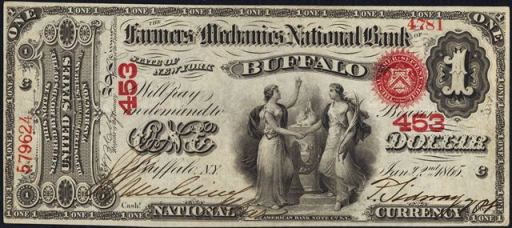
The National Bank Of Lawrence printed 4,000 sheets of $2 original series national bank notes. It is important to know production numbers for original series two dollar bills for informational purposes. All $2 bills printed before 1875 are very rare and highly desirable. Most survivors represent the only known example for that bank. Collectors call these $2 bills lazy deuces. The large two on the face of the bill is pictured horizontally, thus making it look lazy. Don’t be fooled by the silly name though. These can be worth significant amounts of money on many occasions.
Original Series $2 National Bank Note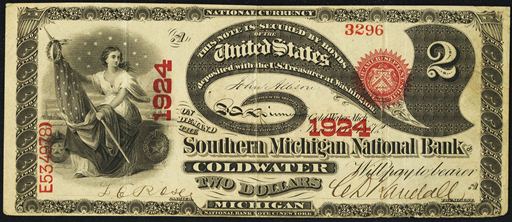
The National Bank Of Lawrence also printed 3,400 sheets of $5 original series national bank notes. It is actually pretty standard for an early national bank to have a sheet output range between 2,500 and 5,000. The exact value of a bill is still going to be based on the number of notes known and the condition of each bank note. Each five dollar original series bank note has a spiked red seal. That is pretty much the only design difference between it and later issues. These are really beautiful notes. One neat thing about these is that the back of each note has a vignette of the corresponding state seal. Some of the state seals are very imaginative. Collecting by state seal was very popular early on in the hobby. Today most collectors are more concerned about bank of issue and condition. Serial number one bank notes are also extremely popular.
Original Series $5 National Bank Note
The National Bank Of Lawrence also printed 2,075 sheets of $10 original series national bank notes. A print range between 1,000 and 2,500 is small. Combine that with something that was printed before 1875 and you can imagine that these notes are few and far between. These notes were issued during the glory days of the national bank note era. Each $10 bill was pen signed by the president and cashier of the bank. Small towns and large cities both issued these notes. Of course the small town issuers tend to be scarcer today. Prices range from $500 to thousands of dollars (and more if the condition and rarity warrant it). Contact us if you need help valuing your bank note.
Original Series $10 National Bank Note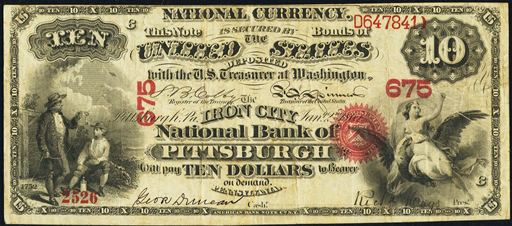
The National Bank Of Lawrence also printed 600 sheets of $1 series of 1875 national bank notes. It is rare to see a sheet output of under 1,000 like this. However, it did happen for some very scarce issuers. Series of 1875 one dollar first charter national bank notes were only printed between 1875 and 1878. That is the shortest production period of any national bank note. That doesn’t automatically mean that these are worth thousands of dollars, but they could be. Collectors often don’t differentiate between original series and 1875 notes because they look so similar.
Series of 1875 $1 National Bank Note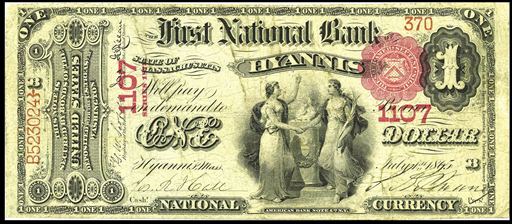
The National Bank Of Lawrence also printed 600 sheets of $2 series of 1875 national bank notes. If you are lucky enough to have a two dollar note from 1875 then don’t get too hung up on the number of bills printed. All notes are rare and in demand; we would be happy to help you value yours. There was only one $2 bill printed per sheet of national currency. So that sheet number also equals the total number of bank notes printed for the denomination. And as we said above, these were also only printed until 1878. That is one of the main reasons they are so rare today.
Series of 1875 $2 National Bank Note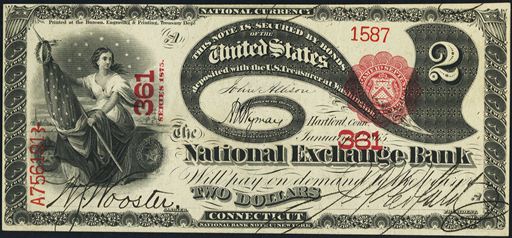
The National Bank Of Lawrence also printed 1,700 sheets of $5 series of 1875 national bank notes. Any time you see a print range between 1,000 and 2,500 you can assume that the bank was small and that their notes could be fairly scarce. Series of 1875 $5 bills are some of the most commonly encountered bank notes from the first charter series. Only the original series $1 bill is more available. Some banks exclusively issued five dollar bills. So if you want an example from one of those banks then you don’t have many options. These notes have a rounded red seal and red serial numbers. They also all have a red charter number.
Series of 1875 $5 National Bank Note
The National Bank Of Lawrence also printed 1,162 sheets of $10 series of 1875 national bank notes. Any time you see a print range between 1,000 and 2,500 you can assume that the bank was small and that their notes could be fairly scarce. The two vignettes seen on 1875 $10 bank notes are “Franklin and Electricity” and “America Seizing Lightning”. These notes occasionally confuse novices because the year 1752 is printed on them. That is when Benjamin Franklin discovered electricity. It has nothing to do with when these bank notes were issued. The back of each $10 bill has “DeSoto Discovering the Mississippi.”
Series of 1875 $10 National Bank Note
The National Bank Of Lawrence also printed 1,067 sheets of $10 1882 brown back national bank notes. That sheet output number is small. Don’t expect too many of these to be available to collectors. There were three $10 bills printed on a single sheet of 1882 brown backs. The design of the bill is similar to all earlier ten dollar national bank notes. The nickname comes from the fact that these bills have a brown seal and brown overprint. Despite saying series of 1882, these were actually printed by some banks up until 1908. The date you see in cursive relates to when the bank first started issuing brown back notes.
Series of 1882 $10 Brown Back
The National Bank Of Lawrence also printed 1,067 sheets of $20 1882 brown back national bank notes. As you can see, the sheet output is the same for $20 brown backs as it is for $10 brown backs. There was only one $20 brown back printed on a sheet. So the sheet output also equals the total note output. One neat thing about all brown backs is that they each have a different back design based on which state issued them. The back left hand side of the note shows the state seal of which ever state the national bank was located in. Generally speaking, 1882 $20 brown backs are pretty difficult to locate. They typically were printed in small numbers and they don’t have a great survival rate.
Series of 1882 $20 Brown Back



